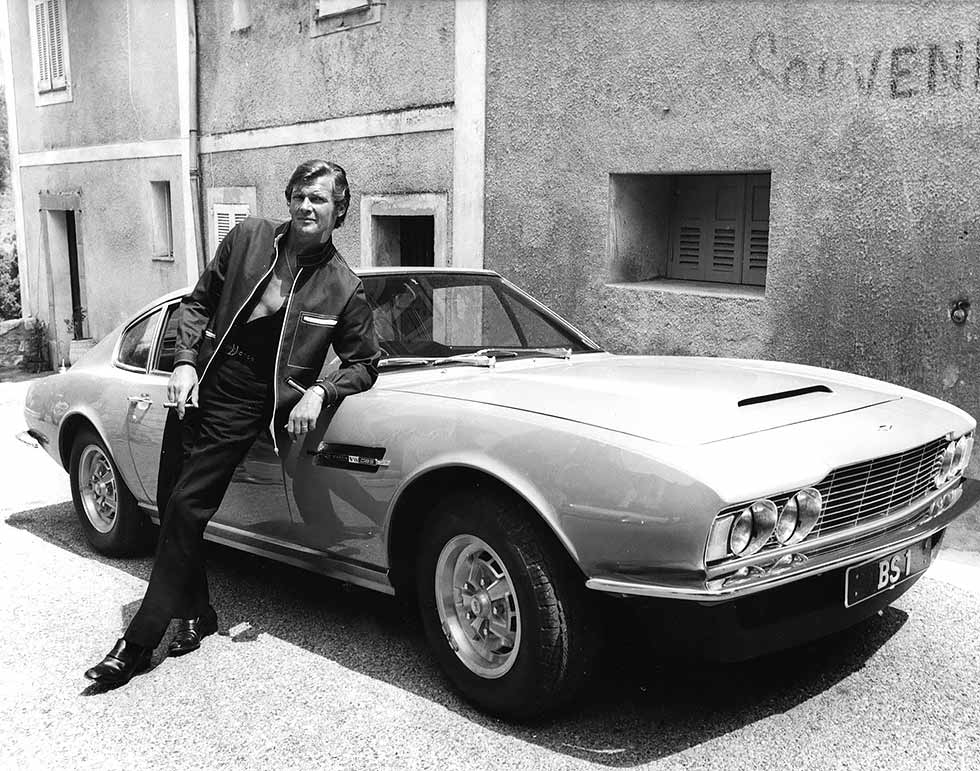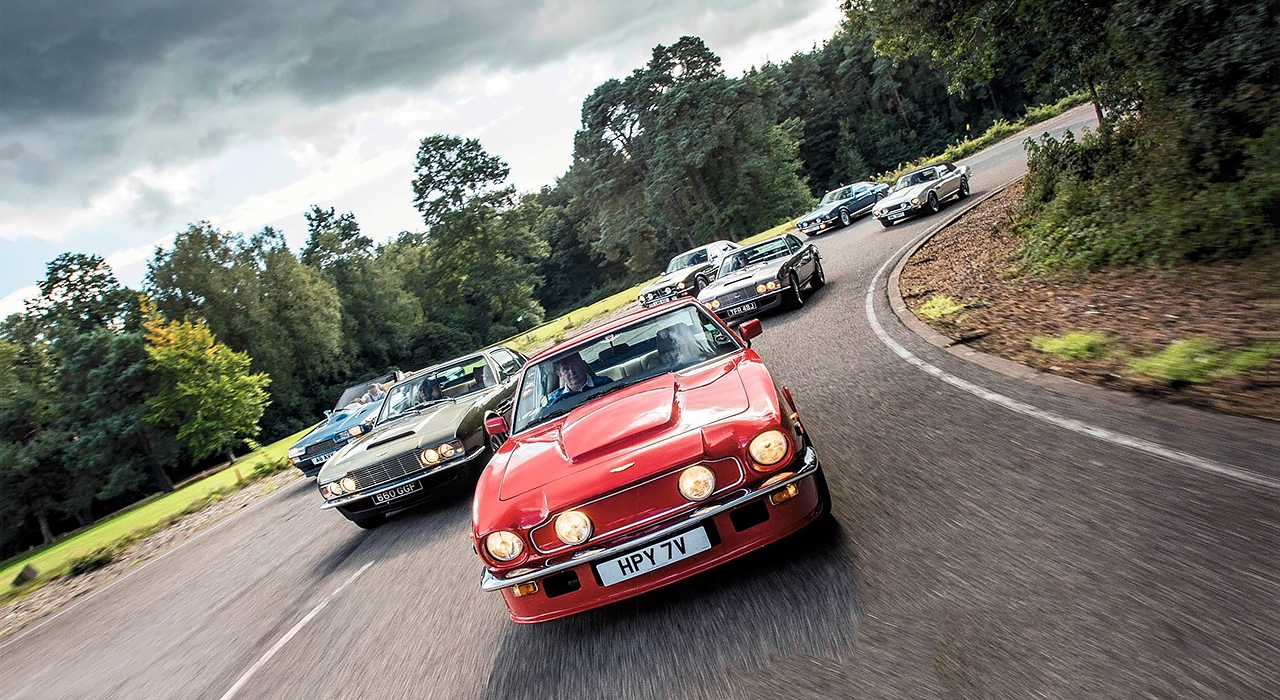
Fifty years ago the DBS sired a generation of Aston Martins that would be built at Newport Pagnell for more than two decades. We gather all the major models for a big – very big – celebration. Words Andrew Noakes. Photography Jonathan Jacob.
‘The DBS is a characterful link between the stability of the David Brown era and the chaos that was to come’
Aston Martin DBS at 50
We celebrate five decades of Aston’s big GT with a drive of every model from DBS to Zagato. Plus stunt driver memories of The Persuaders!
Meet the family – red V8 Vantage leads (clockwise) the original straight-six DBS, Vantage Zagato, Lagonda, Series 5, V8 Volante and DBS V8 saloon.
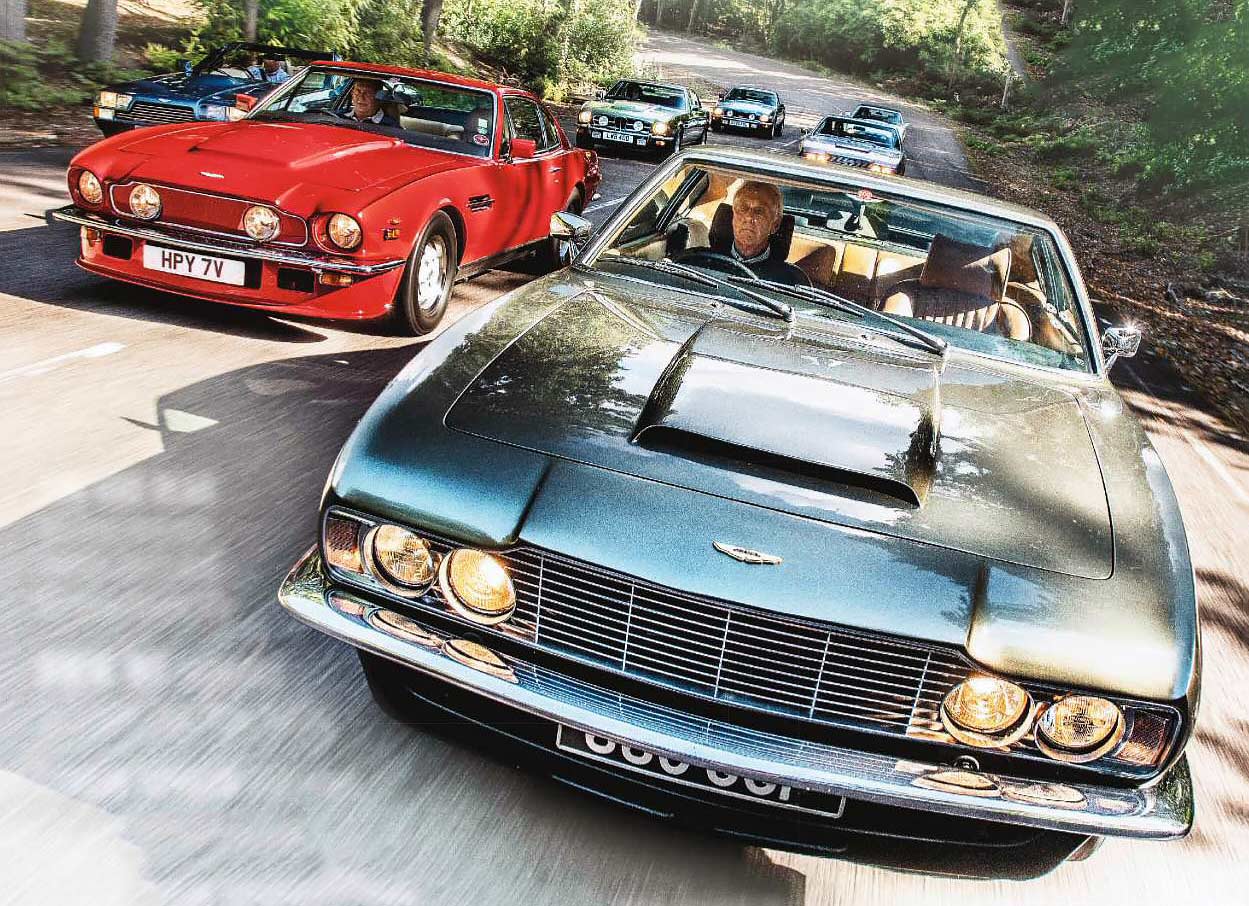
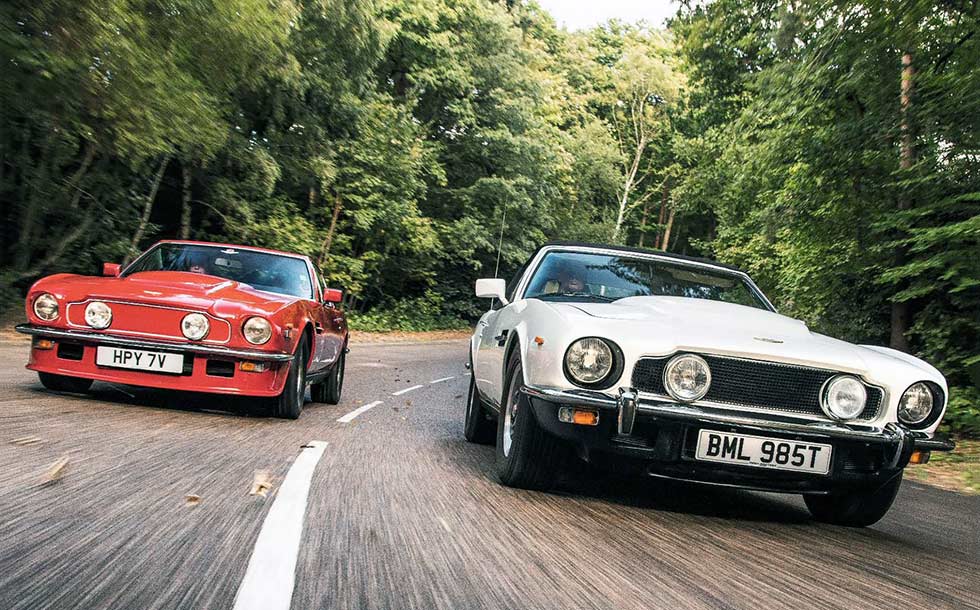
Aston Martin V8 Vantage (left) and Volante lead the charge in our sevencar celebration of the DBS’s 50th birthday.

All these Astons cry out to be driven hard and driven often. Awesome Vantage offers 430bhp and the potential for almost 170mph. Extra steel in the Volante‘s platform ensures the running gear doesn’t ruffle the open body. Even a quick glimpse as it flashes through the trees reveals the fuel injected V8 Saloon’s flat bonnet. The Lagonda brings family-sized practicality without seriously compromising performance. Carrozzeria Zagato meets Aston Martin, for added zest, zip and Italian brio. The US market wanted a convertible version of the V8 – Aston took a long time to comply. Its Vantage Zagato front end makes this Zagato Volante a rarity among rarities. After years of looking dated the DBS is now prized for its shapely styling. Its Vantage Zagato front end makes this Zagato Volante a rarity among rarities.
1967 Aston Martin DBS Vantage
Aston Martin never intended to build the sixcylinder DBS. It received mixed reviews and quickly became a forgotten, apparently irrelevant dead-end in the company’s 103-year history. But 50 years after its launch the model is finally starting to attract the right kind of attention from Aston enthusiasts, so interest is growing and values are on the rise.
To celebrate the six-cylinder DBS and the V8 Astons it spawned we’ve gathered together all the major variants – not just the DBS and DBS V8, but the later V8 saloon, high-performance Vantage and drophead Volante, the incredibly rare Zagato Volante and a Lagonda that these days is almost unknown. Between them they tell the story of the longest-serving generation of Aston Martins and promise driving experiences ranging from subtle to sublime. I’m itching to get behind the wheel to discover if they live up to the legend.
Le Mans 1967 was supposed to be the beginning of a new era for Aston Martin. Two Surtees Racing Lolas were running Aston’s new V8 engine to prove its mettle in competition and drum up a bit of positive publicity ahead of its production debut later that year in the DBS. But things didn’t work out that way.
The Aston-powered Lolas retired early with embarrassing engine failures and when the V8s were stripped down they were found to be badly distorted, prompting a root-and-branch redesign that took two years. In the meantime Newport Pagnell had little choice but to unveil a stop-gap six-cylinder DBS fitted with the twin-cam DB6 motor, which was starting to look old-fashioned in the multi-cylinder landscape of the late Sixties. Jensen and Bristol had both replaced straight-six engines with American Chrysler V8s, Maserati had a V8 of its own and, as ever, V12s were the standard fare at Ferrari and Lamborghini. At least the old six still produced competitive power, even if the 282bhp claimed for the standard triple-SU engine and 325bhp for the triple-Weber Vantage unit – which was a no-cost option – were both a bit optimistic.
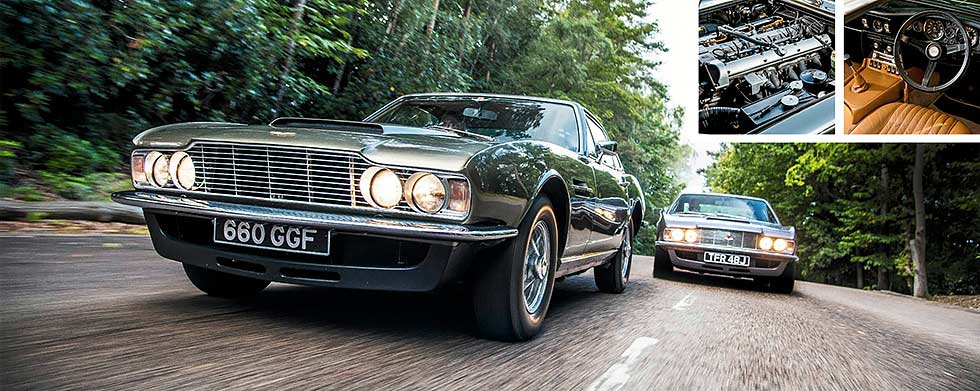
1967 Aston Martin DBS Vantage road test. A V8 engine should have sat in the DBS engine bay but fate dictated it should get the old straight-six. The cabin is pure Sixties GT with more switches and dials than an Apollo lunar module.
The extra power of the Vantage engine was well worth having because the new body designed by William Towns was substantially wider than the DB6 and so had more drag-inducing frontal area. It was heavier too, so the new car was inevitably slower in a straight line than the old one, prompting some harsh comments in the press when the car was revealed. But on a twisty road it was a different story and that was because part of the weight gain had been the result of fitting sophisticated de Dion rear suspension in place of the DB6’s live axle. That gave the DBS better grip and stability as well as a smoother ride quality.
Inside the DBS you’re surrounded by Sixties GT period details, from the fluted leather of the seats to the comprehensive stack of chrome-bezelled gauges. Switches and knobs, strewn rather randomly across the cliff-like facia, look as if they’ve come from a vintage hi-fi unit. Twist the key in the ignition switch on the dash and the big straight-six booms into life then settles to a refined burble. As the revs rise it takes on a cultured, musical quality – but with a touch of rasp to show that it means business.
There’s some heft to the controls but this isn’t a car that’s takes much muscle to drive. Instead it responds keenly to your inputs, flowing through a sequence of bends with a precision that belies its mass, constantly feeding information about the grip at the front wheels back to your fingertips. If it’s wider than you’d prefer for narrow lanes, at least the upturned edges of the front wings – supposedly inspired by the Ford Mustang – make it easy to place on the road. It might not have been a match for a DB6 in a drag race but don’t let that colour your judgment – the DBS is an accomplished driver’s car. A class act.
DBS values are on the rise, the best of them now well into six figures, which suggests the market has finally woken up to how appealing these cars are. Not so long ago a tatty DBS was worth so little that more of them were being broken up than saved, which was a sad fate for a car that has so much to offer.
‘Flowing through bends, the DBS is an accomplished driver’s car – a class act’
Owning a DBS – Graeme Ford
‘It’s a lovely old car. Its first owner was the managing director of Avon Tyres, but he and his two sons were more than 6ft tall and so they simply didn’t fit in the back. He didn’t keep it for long.
‘I bought it when it was six months old. A bus crashed into the side of it once and it got caught in floods, so the interior has been retrimmed. It’s also had new sills. The engine is due for a rebuild – I must do that. ‘They’re good cars. The correct thing to do is to drive them continually – don’t let them stand for more than two or three weeks. That’s the secret, I think.
‘When I go abroad every year I make sure my son-in-law has been in and started it up to check everything works. They have to be driven and maintained – do whatever needs doing – don’t put it off. Mechanical parts are DB5 and DB6, so spares are no problem.’
TECHNICAL DATA 1967 Aston Martin DBS Vantage
Engine 3995cc in-line six-cylinder, dohc, 12-valve, three Weber 45DCOE carburettors
Power and torque 325bhp @ 5750rpm; 290lb ft @ 4500rpm
Transmission Five-speed manual ZF gearbox or Borg-Warner three-speed automatic, rear-wheel drive
Suspension
Front: independent, double wishbones, coil springs.
Rear: de Dion tube, trailing arms, Watt link
Steering Rack and pinion, power-assisted
Brakes Discs front and rear, servo-assisted, inboard at rear
Weight 1589kg (3503lb)
Performance Top speed: 140mph; 0-60mph: 7.5sec
Values now £40,000-£150,000
1969 Aston Martin DBS V8
Engineering guru Tadek Marek began work on Aston’s DBS V8 engine in the early Sixties and prototype motors of 4983cc and then 5064cc were tested in a very rapid DB5. They would also have gone into DP215, the third of Aston’s ‘Project’ GT racing cars, if the decision had not been taken to pull out of motor racing as a factory team at the end of 1963. Marek retired in 1968, after the Lola Le Mans debacle but before the engine reached production, and Alan Crouch led the redesign team. He stiffened the cylinder block, beefed up the main bearing housings and clamped the cylinder heads in place with longer bolts so that the stresses were channelled into the heart of the block instead of being concentrated at the top. By the time the definitive production V8 was unveiled to the motoring world in 1969 it was a much more robust unit, while both bore and stroke had been enlarged to expand capacity to 5340cc.
Dismayed by a massaging of power figures that was rife at the time, Aston Martin declined to quote an official output. However, the reality was that the V8 offered about 345bhp, a useful increase over the real output of the 4.0-litre straight-six. Fed by Bosch mechanical fuel injection, it also offered a much wider torque band with 300lb ft available from 2000rpm right the way through to 6000rpm. This considerable heft was delivered through either a new dog-leg ZF five-speed manual gearbox or a three-speed Chrysler Torqueflite automatic.
Under the bonnet it looks terrific, with individual intake pipes leading to the combustion chambers from plenum chambers on either side of the engine bay. They almost hide the crackle-black cam covers carrying bold Aston Martin Lagonda legends. Outside, the DBS V8 looks much the same as the six-cylinder car. The most obvious change is the addition of an air dam at the front, necessary to ensure high-speed stability in a car that was now capable of around 170mph. There was also a switch from wire wheels to GKN alloys that were shaped to draw hot air away from the Girling vented disc brakes.
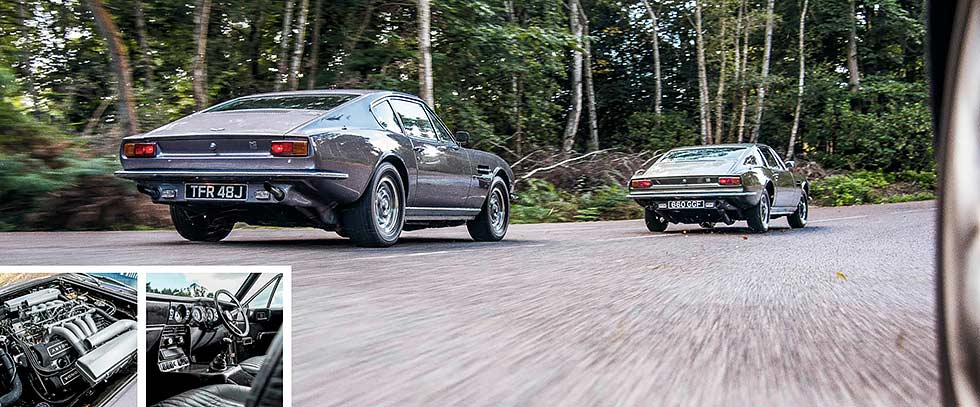
1969 Aston Martin DBS V8 road test. Quad cam V8 came late to the DBS following development problems. Inside, the steering wheel now connects to a nicely weighted power-assisted system.
In the cabin the leather-wrapped steering wheel, carrying the angular DB logo, now has power assistance as standard fit so you don’t need to work hard to steer the V8, but you can feel the extra weight of the car in its fractionally slower response to the helm. The steering is beautifully weighted, light enough to turn without any real effort but weighty enough to avoid any feeling of nervousness, and with damping that somehow isolates road shocks but still allows important feedback to filter through. If anything there’s more grip, and this car has stiffer aftermarket anti-roll bars that keep roll well in check, although a little of the delicacy has been lost.
The star of the show has to be the engine. It fires up easily and revs cleanly with a boomy, bassy exhaust note that has a lot in common with the six-cylinder car. But the performance on offer is in a different league. Where the six-cylinder DBS is pleasantly swift, the V8 is seriously fast. The dog-leg change of the ZF gearbox has a long fore-aft throw but the lever slots cleanly into each position and when you squash the accelerator into the Wilton the V8 just squats on its rear tyres and flies, the tachometer needle sprinting around to 6000rpm without any aural hints of stress from the engine. Even if you’re just ambling along the sound of the V8 dominates the proceedings, with an ever-present rumble and plenty of punch at any speed and in any gear.
The flexibility and performance provided by the Bosch injection are easy to appreciate but it proved troublesome in its early years. The good news is that today the system can be made reliable, but it was that reputation for unreliability as much as anything that kept DBS V8 values down compared to the later V8s, and even now they tend to lag a little behind the values of top-notch six-cylinder cars. They shouldn’t. The DBS isn’t the better car, just a different one, and the V8 has plenty of appeal of its own.
Owning a DBS V8 – Steve Prevett
‘I always hankered after one after watching James Bond and The Persuaders! I paid £14,000 for it in 2000 – it wasn’t as nice as it is now but it wasn’t bad. I just loved it and I’ve never looked back.
‘It’s a great car to drive – you can do long journeys in it with total reliability. I’ve had lots of classic cars but I’ve never had one as good as this.
‘I’m really pleased with the engine rebuild carried out by Aston Engineering. Before I had it rebuilt it was all over by about 4500rpm, but now it comes alive at about 4000rpm and it’s still pulling at 6000rpm. Peak torque is about 5000rpm, quite high. It’s got lots of oomph – these fuel injection cars out-perform the carburettor cars every time. I love sweeping bends – it’ll just dig in and you feel totally confident. It feels old, yet it drives just as you’d want it to. ‘They’re not fragile. I’ve driven it hard for 15 years and never worried. It just goes and keeps going. I’ve never had any calamities with it – the only thing it’s done in 16 years is throw a water pump, but any car could do that.’
TECHNICAL DATA 1969 Aston Martin DBS V8
As previous except: Engine 5340cc V8, dohc per bank, Bosch mechanical fuel injection
Power and torque 345bhp @ 6000rpm; 360lb ft @ 4000rpm
Weight 1725kg (3802lb)
Performance Top speed: 170mph; 0-60mph: 6sec
Values now £40,000-£225,000
‘When you squash the accelerator into the Wilton the V8 just squats on its rear tyres and flies’
1974 Aston Martin Lagonda 7.0
William Towns’ original DBS designs were for a family of cars including a short-wheelbase sports car and a four-door saloon 11 inches longer than the DBS and with a fastback profile ten years ahead of its time. Once the DBS was launched and the DBS V8 was well advanced, Aston Martin turned its attention to the longer car, resurrecting the Lagonda badge that had been dormant since the demise of the Rapide in 1964. Work began on a prototype Lagonda in 1968 and the car was used extensively by Sir David Brown. Originally fitted with wire wheels and a prototype 5.0- litre V8, it was later updated with DBS V8-style alloys and a 5.3-litre production engine. Aston Martin was keen to put it into production in 1970, but by then the DBS V8 was accounting for as many engines as the company could build so the Lagonda project was shelved.
By the time it reappeared in 1974 a lot had happened at Newport Pagnell. David Brown had sold the company in February 1972 and the DB nomenclature had been dropped, so the DBS V8 became simply the Aston Martin V8 and the six-cylinder DBS Vantage became the short-lived Aston Martin Vantage. At the same time a new two-headlamp front end was adopted, then the following year a combination of reliability problems and US emission laws led Aston Martin to drop fuel injection and revert to Weber carburettors, necessitating a taller bonnet bulge. The extra cost of the injection system probably played its part too. The production version of the Lagonda, unveiled at the London Motor Show in October 1974, carried over the carburettor engine and had a modified front end housing a unique grille.
But the Lagonda had barely been launched before Aston Martin ran out of money because of falling sales caused by the early Seventies oil crisis and the investment needed to certify the V8 engine for sale in the US. As the company went through bankruptcy, uncertainty and then rescue by an Anglo-American consortium in 1975-1976, just seven production Lagondas were built, one of them for Aston Martin Lagonda’s then-chairman, William Willson. There was also one spare chassis, which was built up many years later into a complete car by Roger Bennington of Aston Martin specialist Stratton Motor Company.
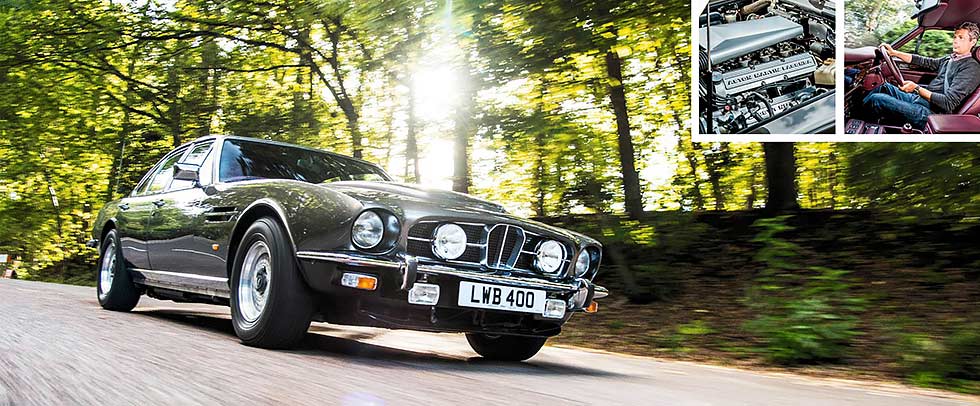
1974 Aston Martin Lagonda 7.0 road test. This Lagonda’s 5.3-litre V8 has been replaced by a 7.0-litre RS Williams unit good for about 480bhp and 170mph. It’s a genuine four-seater, with the rear chairs as comfy as the fronts if you’re not too tall.
The Lagonda here is that 1974 motor show car, currently in the care of Aston Martin Works, the company’s historic car division, still based in the same premises in Tickford Street, Newport Pagnell where all these cars were built. A bit of an anachronism now, it was the third production car built but was treated to a full restoration a few years back that included later-spec rear bodywork, a respray in Cumberland Grey, an updated interior retrimmed in burgundy hide and a 7.0-litre RS Williams engine.
Although I’m looking forward to unleashing that monster engine, I start in the Lagonda’s back seat to see if it really stacks up as a fourdoor saloon. The low roofline makes access to the rear rather tricky, and once inside there isn’t much headroom – but the upright rear seat position means legroom and kneeroom are surprisingly generous. Sitting here surrounded by fine leather and polished walnut would be a very pleasant way to travel, as long as you’re not too tall.
Behind the wheel, which is an Eighties-spec two-spoke item that’s too small for my taste, the Lagonda is much the same as an Aston V8. The extra power of the 480bhp RSW engine balances out the weight of the long-wheelbase body, so performance is about the same as that of the two-door car. The longer wheelbase and extra mass make the Lagonda a fraction less inclined to turn into a corner and render it more of a cruiser than a sports car, but that fits with its intended character as a well-heeled express rather than a raw-edged sports GT. It’s a comfortable and cultured way to travel, and it’s a shame that so few were built.
‘The extra power balances out the weight of the body, so performance is about the same as the two-door car’
Driving an Aston Martin Works Lagonda – Thomas Reinhold
‘This V8 Lagonda Series One is pure driving pleasure. It is a unique and rare motor car, far more so than other competitive marques of the time. Maintenance is easy and relatively inexpensive through Aston Martin Works, and because it’s a stretched V8 saloon there is a great commonality of parts and design.
‘The greatest joy of the Lagonda is that your friends and family can come along for the ride and share the exclusivity with you in complete luxury. And the RS Williams 7.0-litre conversion, commissioned by the previous owner, enables it to more than hold its own when pitted against modern rivals. ‘We have looked after this car at Aston Martin Works since its rebuild to concours standards in 2002 – and we carried out a major mechanical overhaul in 2004. Noteworthy additions include a Becker navigation system, heated front seats, seatbelts to the rear and a concealed Motorola phone, complete with handset, for the rear passengers.’
TECHNICAL DATA 1974 Aston Martin Lagonda (with 7.0-litre conversion)
As previous except: Engine 7000cc approx, four Weber 48IDA carburettors
Power and torque 480bhp @ 5000rpm; 520lb ft @ 3000rpm
Weight 2000kg approx (4410lb)
Performance Top speed: 170mph approx, 0-60mph: 5sec approx
Value now £450,000
1977 Aston Martin V8 Vantage X-pack specification
The fastback Lagonda was replaced by a new wedgeshaped saloon unveiled in 1976, which brought not just radical new styling and high-tech digital instruments but also a new chassis and a revised engine. A low-profile induction system had to be developed to squeeze the Aston V8 under the new Lagonda’s low nose, and new big-valve cylinder heads were developed to restore the power lost due to the more restrictive intake. It wasn’t long before the big valves found their way into an Aston V8 as part of a new high-performance variant. In 1969 Aston Martin had considered building a more powerful DBS V8 Vantage, but with demand for the existing DBS V8 outstripping engine supply neither the Vantage nor the V8 Lagonda were pursued at that time. By 1977 Aston Martin had survived the traumatic mid-Seventies and was ready to expand its model range, and a Vantage version was considered again.
The V8 Vantage used the big-valve cylinder heads developed for the Lagonda, skimmed to raise the compression ratio. It also got higher-lift camshafts – actually the same profile as those in the injected DBS V8 engine – and pocketed pistons to provide clearance for the valve heads. Fuel and air were supplied, in suitably epic volumes, by a quartet of vast Weber 48IDA carburettors, and there was a big-bore exhaust system. There were stiffer rear springs and larger Pirelli CN12 tyres, and to cut lift and drag the front end received a deep air dam and blanked-off grille while a lip spoiler was added at the back. At first the spoiler was clearly an add-on, but later it was integrated into a reshaped rear end that was also adopted by the V8 saloon in a 1978 update known internally by the codename ‘Oscar India’ for October introduction.
The neatly integrated tail spoiler is obvious on Alan Medland’s bright red Vantage, which dates from 1980. This car has also been updated to the later Vantage engine specification known as the X-pack – it has even bigger valves, raising the power output to around 430bhp. Like all the carburettor Aston V8s it needs a bit of finesse to start. When the engine is cold it’s best to ignore the choke and instead pump the accelerator three or four times to richen the mixture, then turn over the engine on the starter until it catches a cylinder at a time. Apparently it’s best to avoid a halfhearted spin on the starter, as that invites a blowback followed by a carburettor fire. With a warm engine the best strategy is to push the pedal half way to the floor to encourage some air flow through the big throttles, then the big V8 erupts into life with a satisfying roar through the fat exhaust.
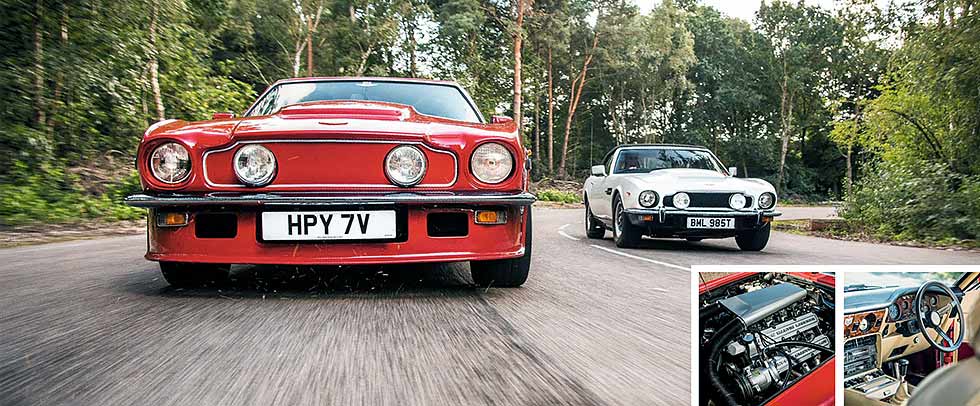
1977 Aston Martin V8 Vantage X-pack specification. Behind the blanked-off snout lies the Vantage V8 with big valves, high lift cams and raised compression. Owner Alan Medland’s advice is to drive it hard, not pootle around.
The clutch needs a determined shove, but like the long-throw gearchange it engages with a smooth, well-oiled action. The brakes are heavy too, but that’s all to the good because the solid pedal provides a secure pivot for heel-and-toe downchanges.
The V8 may be big, but its throttle response is scalpel-sharp. Add in the infectious sounds of eight gasping Weber barrels and the bellow from the drainpipe exhaust and you’re soon changing up and down through the dogleg gearbox more for fun than because there’s any real need to do so.
The steering joins in the sensory stimulation, wriggling enthusiastically between your fingers as the bigger tyres traverse imperfections in the asphalt. Not that the Vantage is troubled by an uncertain surface, because the de Dion rear end keeps the tyres vertical and provides commendably consistent grip as it hauls its considerable mass out of a corner. Only the weather slows it down – injudicious application of throttle will spin the rear wheels in third gear if the road is wet.
But, in the dry at least, the Vantage is nowhere near as intimidating as its prodigious output and aggressive looks suggest it should be. It takes only a few miles to realise that the Vantage feels like a staunch ally that will flatter your skills behind the wheel and forgive all but your most egregious errors.
Owning a V8 Vantage – Alan Medland
‘I had an Oscar India V8 saloon but my dream car from when I was 17 years old was a Vantage. I’ve had it 11 years. It’s an ex-Rowan Atkinson car – he had a red Zagato too.
‘There’s no witchcraft in it – it’s engine, gearbox, steering, brakes, clutch – so it’s nice and basic, which is what I like. You just get in it and have some fun. It doesn’t like local trips, doing 30mph. Get it to 120mph, floor it, and it still pulls like a train. It’ll go in any gear. It does run better when it’s had a caning – when it hasn’t, the interior mirror starts vibrating.
‘It’s had a couple of carburettor fires, which have been rectified. But, touch wood, it’s always got me home, every time. It was doing flat out runs at RAF Cottesmore and nearly dropped a valve. It was in for conversion to unleaded shortly after and they noticed corrosion on a valve seat. It now has the X-pack engine’s bigger valves.
‘The only problem is that it drinks like hell. It does about 9-10mpg, but on a long gentle run we can get 15 out of it. It’s still my dream car, though.’
TECHNICAL DATA 1977 Aston Martin V8 Vantage (X-pack specification)
As previous except Engine 5340cc, four Weber 48IDA carburettors
Power and torque 430bhp approx @ 6000rpm, 400lb ft @ 5000rpm
Weight 1818kg (4008lb)
Performance Top speed: 168mph; 0-60mph: 5.4sec
Values now £55,000-£350,000
‘The Vantage is nowhere near as intimidating as its prodigious t output suggests it should be’
1978 Aston Martin V8 Volante
Aston Martin took its striking new wedge-shaped Lagonda to the Los Angeles motor show in 1977, but managing director Alan Curtis was surprised to find that many of the enquiries made at the show were not about the Lagonda at all. What Californians wanted to know was when a convertible version of the V8 would be available.
Over the years most Aston models had been available in drophead form but the factory had never built DBS or V8 convertibles, though a few had been constructed from fully built cars by FLM Panelcraft. American safety legislation had been expected to ban open cars entirely, and anyway Aston Martin had been too busy with changes of ownership, receivership, reorganisation and the work required on the Lagonda’s troublesome electronics to work on a convertible. But the regulatory threat never emerged and by the late Seventies Aston was back on a more stable financial footing. Realising there was a ready market for the open-top car, Curtis quickly put it on the Aston agenda.
It was called the V8 Volante, recycling a name (the Italian for ‘flying’) that had been applied to open DB6s. Mechanically it was the same as the V8 saloon and it used essentially the same steel platform chassis that could trace its lineage back to the 1958 DB4, but the hand-crafted aluminium alloy bodywork was very different.
The front end was shared with the saloon, although there was a new, neater, bonnet with a power bulge rather than a scoop – intake air was now taken from an aperture at the back, in the bubble of high pressure air at the base of the windscreen. The flat rear deck was new, and the rear wings were reshaped to suit the convertible roof. That roof was a masterful piece of work by George Moseley, who had designed the Corniche convertible top for Rolls-Royce. He charged Aston Martin £5000 plus £150 royalty for every car sold. It looked elegant when it was raised and folded almost flush with the waistline of the bodywork, making the Volante just as neat with its roof lowered. Passenger space wasn’t compromised, though the already small boot became even more tiny.

1978 Aston Martin V8 Volante road test. Raising the V8 Volante’s roof creates rear-three- quarter blind spots, but that’s its only drawback. A power bulge in the bonnet takes intake air from its rear edge.
Raising the powered roof reveals a drawback. Because there are no rear quarter windows in the hood and the plastic rear window is quite small, there are massive blind spots over both your shoulders that make negotiating angled junctions nerve-racking. Dropping the roof, by unclipping two header rail catches and pushing a button by my right knee, solves the problem and at the same time configures the Volante at its most glamorous, giving passers-by a glimpse of the finely crafted interior with its standard wood veneer trim and its well-heeled occupants.
Extra steel in the platform chassis does a good job of stiffening the structure, so only the biggest bumps disturb the Volante’s composure. The rustle of wind noise at speed is greater than in the fixed-roof cars but the Volante is a fine cruiser whether the top is raised or lowered. With automatic transmission and a carburettor engine that’s down on power compared to the injected DBS V8 it’s clearly not as quick, but it nonetheless accelerates with plenty of verve and has an appealingly gruff, gravelly engine note. In fact, despite a minor weight penalty, the Volante is near enough as quick as the contemporary saloon, so choosing the convertible didn’t mean compromising straight-line pace or handling prowess. The only drawback was the price, which was a hefty 50 per cent more than that of the saloon.
Despite this the Volante was an instant hit, outselling the Lagonda and saloon combined. Its popularity was in part because full convertibles were then a rarity, with the bigger, slower and even more expensive Corniche the only other premium-class option – though Volante buyers might also have considered Bristol’s targatopped 412 or a two-seat Mercedes-Benz 450SL R107 at half the price. Today they’re worth much the same as V8 saloons.
Owning a V8 Volante – Grace Curzon-Price
‘I wanted to be driven to my wedding in a white Aston Martin V8 convertible. I thought my fiancé had borrowed it – but he had found a sad, damp, tired Volante and had Chiltern Aston restore it. Every trace of paint was removed, then the bodywork was honed to perfection and the chassis rebuilt. The brightwork was rechromed, the woodwork restored and re-lacquered, and ten hides of leather used to re-upholster it.
‘It had four previous owners before us and had covered more than 120,000 miles. We’ve owned it for five years and further restoration has seen a gearbox upgrade, a sports exhaust system and a top-end overhaul with carburettor rebuild. This year it had an extended visit to Trinity Engineering who stripped down and rebuilt the front and rear suspension and the brakes and replaced the steering rack. It runs and handles superbly now, as well as sounding like a big Aston Martin should.
‘The nearest we’ve come to a breakdown is running out of petrol – something you need to keep a very close eye on.’
TECHNICAL DATA 1978 Aston Martin V8 Volante
As previous except Engine Four Weber 42DCNF carburettors
Power and torque 320bhp @ 5000rpm, 360lb ft @ 4000rpm
Weight 1795kg (3957lb)
Performance Top speed: 150mph; 0-60mph: 7.5sec approx
Values now £40,000-£150,000
‘The Volante is near enough as quick as the saloon, so it doesn’t compromise straightline pace or handling prowess’
1987 Aston Martin V8 Saloon
Ironically the same issue that forced Aston Martin to abandon fuel injection in the early Seventies – increasingly stringent emissions rules – forced the marque to abandon carburettors in the Eighties. By then the state of the art was electronicallycontrolled injection with full engine management, which offered much more precise control to give cleaner and more efficient combustion, and Aston Martin adopted a Weber Marelli system on the V8 saloon in 1986. Ditching the quartet of tall downdraught carburettors meant there was no longer any need for a bonnet bulge to clear the airbox, so a new flat bonnet was designed to smooth out the front end. At the same time it removed a long-standing bugbear for short drivers, who had always complained of being unable to see over the bonnet bulge to the nearside front corner of the car. Along with the BBS cross-spoke alloy wheels adopted by Aston Martin in the early Eighties, the new appearance effectively turned what was now a two-decades-old design into a much more modern-looking car.
It feels more modern inside too. The leather is as fine as ever and the mirror-polished wood veneer trim is de rigueur, but now there is a uniform collection of black plastic switches distributed across the facia in place of the previous apparently random assembly of plastic, chrome and bushed aluminium switchgear. The column stalks, from the Vauxhall Cavalier MkII, work well enough but their humble appearance is out of place in the rarefied interior of an Aston Martin.
There’s the more modern two-spoke steering wheel we’ve already encountered in the updated Lagonda – and it still feels too small and with the spokes in the wrong place for me to feel comfortable holding it. Despite the updates made inside the cabin, the close windscreen, slim pillars and fly-off handbrake give away the age of the basic design, while the view through the front screen is less of a treat than it was in the earlier cars thanks to the flat expanse of featureless bonnet ahead.
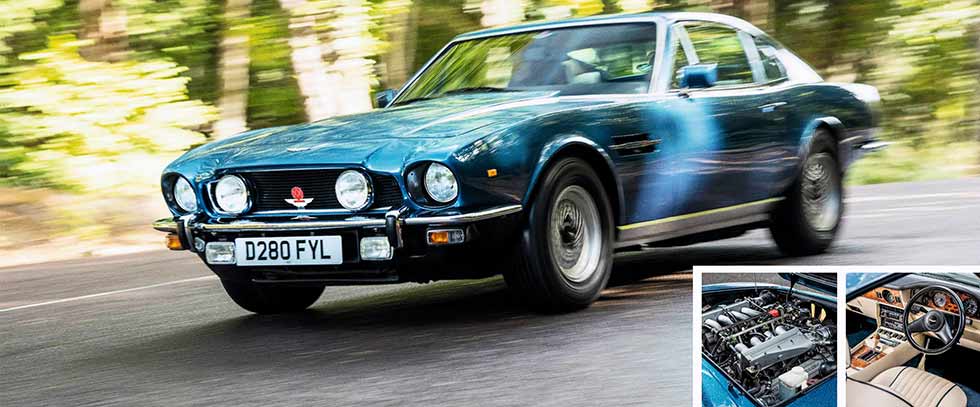
1987 Aston Martin V8 Saloon road test. Resuming Aston’s on/off affair with fuel injection by giving the V8 saloon a Weber-Marelli system did away with the bulky carburettors and bonnet bulge. The luxury cabin is more orderly, though Vauxhall column stalks nibble at the ambience.
Still, at least this is an Aston V8 that starts on the key rather than requiring fancy throttle footwork to tickle into life, cylinder by cylinder. The injected engine is smoother too, with an induction note that’s cleaner, crisper and quieter, but also arguably a bit less characterful than the roar of the carburettor-fed cars. Much the same applies to the rest of the late V8 – you can feel and hear how two decades of constant development have polished the basic design, smoothing the ride and quelling vibration, and it’s the extra layer of refinement that makes the late V8 so deceptive in its performance. Give the accelerator a determined prod and the Torqueflite automatic gearbox snaps urgently into second, punching the Aston up to illegal speeds with only an urbane rumble from the exhaust to give the merest indication of effort. The powerful vented discs still need a firm push of the pedal, but they haul the speed down without complaint.
Although the steering is as precise as ever, something about the geometry has changed or else the cornering forces are acting through the new lower-profile tyres in a different way. Whatever the reason, it makes the effort required at the rim increase noticeably as you ask more of the chassis through a corner, to the extent that some of the feel and feedback is masked. It’s a little less involving but more modern and more refined, factors that would make this car a great long-distance cruiser.
In this form the Aston Martin V8 saloon – Aston always called them saloons despite the fastback coupé profile – continued in production until it was replaced in 1989 by the Virage. The new car used a heavily reworked V8 engine with four-valve cylinder heads and a chassis based on the one developed in the mid-Seventies for the wedge-shaped Lagonda.
By the end of the Eighties more than 2000 Aston Martin V8s had been built over the best part of two decades, making it the biggestselling Aston and representing almost a fifth of the cars Aston Martin had made since it was founded in 1913.
‘Feel and hear how two decades of constant development have polished the basic design’
Owning a V8 saloon – Jon Bellfield
‘I’ve owned this car since it was new. In the early Seventies, when Company Developments briefly owned Aston Martin, several businessmen in the Midlands with connections to Company Developments had Aston Martins. At that time I always aspired to have one as and when I could afford it. The opportunity arose in 1986 and I ordered the car to my specification from Chapman Spooner.
‘The car was initially for my everyday use and it covered about 16,000 miles during the first 12 months. Subsequently it has mainly been used for high days and holidays, although it has had a couple of outings to Europe and also did three parade laps at Le Mans one year. It has been predominantly trouble-free apart from needing a replacement gearbox. ‘The reason I’ve kept the car so long is that I still enjoy driving it and being one of the later models it is very comfortable with central locking and aircon. Compared to modern Aston Martins it is much more spacious and suitable for touring purposes.’
TECHNICAL DATA 1987 Aston Martin V8 Saloon
As previous except Engine Weber-Marelli fuel injection
Power and torque 305bhp @ 6000rpm; 320lb ft @ 3000rpm
Weight 1818kg (4008lb)
Performance Top speed: 150mph; 0-60mph: 7sec
Values now £35,000-£165,000
1990 Aston Martin Vantage Zagato Volante
At the Geneva show in March 1984 the Aston Martin and Zagato stands were right next to each other and that coincidence kick-started talks between the two companies about reviving the partnership that had created the DB4GT Zagato in the Sixties. The limited-edition V8 Vantage Zagato announced at the following year’s Geneva show promised more power, lighter weight, better aerodynamics and truly exceptional performance – Aston Martin talked of a top speed of 186mph and a 0-60mph sprint in less than five seconds. Potential buyers must have been impressed by what they heard because by the summer of 1985 all 50 production cars had already been sold.
While Zagato worked on the shape of the new car, Newport Pagnell developed the engine and suspension. A V8 Vantage works development car, VNK 360S, was lightened by removing the rear seats, interior trim, air conditioning and spare wheel well, and replacing the glass side windows with Perspex, until it was about ten per cent lighter than a standard Vantage – the expected final weight of the Zagato. Variable-rate springs and Koni dampers were added, and there were new 16-inch wheels with Goodyear Eagle tyres, which suited the car better than the Pirellis used on production Vantages.
Shorter overhangs helped to slim down the Zagato and the angular body with its trademark Zagato ‘double bubble’ roofline had an impressive drag coefficient of 0.29. However, it ended up at 0.33 after wind tunnel testing revealed a need for a front air dam and bootlid spoiler to reduce high-speed lift.
Originally the plan had been for a fuel-injected V8 but development of the injection system was delayed while Aston Martin worked on injecting the mainstream V8. Instead the Vantage Zagato was given the big-valve, carburettor-fed engine originally developed for a South African V8 Vantage customer, with 432bhp in the original prototype and about 410bhp in production cars – though Aston’s Works Service uprated several cars for its new owners. The Zagato’s low bonnet left no space for the big carburettors, so the development car was given an ugly bonnet bulge and Zagato set to work penning a more shapely version for the production cars, the first of which was delivered in July 1986. On a French autoroute the Zagato achieved 298.75km/h, just under 186mph. That made it the fastest production car Aston Martin had yet built.
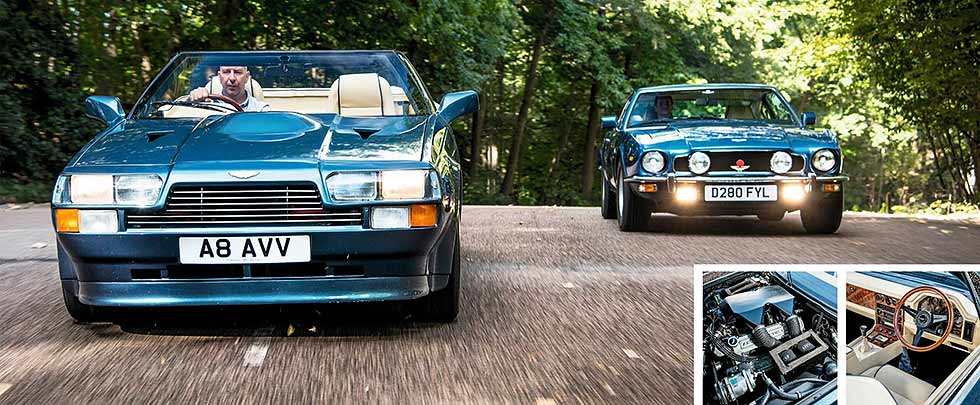
1990 Aston Martin Vantage Zagato Volante road test. A handful of the 37 production Zagato Volantes, including this one, had the quad-Weber 410bhp Vantage Zagato V8 instead of the non-Vantage 320bhp fuel-injected unit. Slim, well-shaped seats place both occupants better in the cabin.
The convertible Zagato Volante made its public debut at the Geneva show in March 1987. The Volantes had a new front end with concealed headlamps and a blanked-off grille, and there was no bonnet bulge because the engine was a non-Vantage fuel-injected V8. Jim Craig’s car is one of only a handful of the 37 production Zagato Volantes built with the Vantage Zagato engine and front end, complete with the prominent bonnet bulge.
With the top down but the windows raised you can hold a conversation in the cabin even at speed, but still enjoy plenty of fresh air and the ever-present roar of the tuned V8. The cabin is swathed in even more leather than the British-built Astons and the squared-off Zagato facia is very different from Aston’s version but not really any more attractive. But the slimmer, more shapely seats are a welcome bonus because they locate the driver and passenger better in the car. My view from behind the wheel is dominated by the bonnet bulge and a NACA intake duct on the bonnet, and is none the worse for that.
The shorter, lighter Zagato has an extra zest to its handling that’s obvious as soon as it starts to move. It feels alert and alive, with a keenness that was lost as the V8 cars gained weight. I could do without the slippery Nardi wood-rimmed steering wheel, but otherwise this is the best of the bunch to thread down a winding country lane and in the right hands it would be the fastest car here, though it’s probably not quite as forgiving as the Vantage.
Owning a Zagato – Jim Craig
‘I owned a V8 Oscar India for five years and more recently a V8 Vantage Volante X-Pack. I sold that on but had a hankering for another V8, though a Zagato was not really in the frame as they don’t often come up for sale.
‘I’ve only owned this for two days and have done 338 miles in it so far. I calculated my mpg as less than ten! I think it will benefit from a tune – the fuel consumption will never be good but on a motorway I should be getting 15. ‘The mechanicals are straightforward Aston Vantage X-Pack – the usual bugbear with that is leaking core plugs. The main things to check on a Zagato are bodywork and trim, which can be difficult to source. A lot of it is from production Italian cars – the wiper motor is from a Fiat and the doors are re-skinned Maserati Bi-Turbo. It is the custom Zagato parts that can be difficult to source.
‘I think people now see these as the lightened sports cars they were always envisioned to be. The styling was five years out of date when they were released, but 30 years on it is now seen as classic Eighties design – and all the better for it.’
TECHNICAL DATA 1990 Aston Martin Vantage Zagato Volante
As previous except Engine Four Weber 48IDA carburettors
Power and torque 410bhp @ 6000rpm; 395lb ft @ 5000rpm
Weight 1650kg (3637lb)
Performance Top speed: 186mph; 0-60mph: 5sec approx
Values now £75,000-£200,000
“The Zagato has an extra zest to its handling that’s obvious as soon as it starts to move. It feels alert and alive”
Сonclusion
Fifty years on, Aston buyers are finally waking up to the genuine appeal of the DBS. It’s a characterful link between the Touring-shaped DB4/5/6 and the V8s of the Seventies, between the stability of the David Brown era and the chaos that Aston Martin was to suffer in the years to come. The DBS deserves its place in history as the progenitor of a generation of Astons that saw the company survive oil crises and bankruptcy to reinvent itself under Ford ownership at the end of the Eighties. Choosing a winner from among these cars is tricky.
Feedback from all the owners is that they’re all tough, dependable machines provided you look after them properly. Each one has its own merits. I love the art deco badges, the Sixties interior ambience and the cultured soundtrack of the DBS, but also the response of the DBS V8 and its under-bonnet appeal. The Volante adds glamour, the Lagonda adds class and hyper-exclusivity, while the late V8 saloon has an extra touch of finesse the others lack. But the two I’d agonise over most are the Vantage and Zagato. Epic performance is assured in both, but one delivers it with hyperactive spirit while the other offers non-nonsense competence.
That bright red Vantage would be the car I’d take home, but I’d still always hanker after an Italian Aston.
Thanks to: Aston Martin Works (astonmartinworks.com), the Aston Martin Owners’ Club (amoc.org) and Aston Martin Heritage Trust (amht.org.uk)
The Vantage takes the honours for our man Noakes, though the Zagato runs it a close second. What’s your choice? Let us know.

{CONTENTPOLL [“id”: 85]}
RICK LESTER: Roger Moore’s stunt driver double
Rick Lester performed spectacular stunts in a string of Sixties action movies, including the Bond films. He then doubled for Roger Moore in the 1970 film The Man Who Haunted Himself, driving a Rover P5 and Lamborghini Islero.
He teamed up with Moore again for The Persuaders! The hit TV series featured Moore’s character Brett Sinclair driving a Bahama Yellow DBS carrying the registration ‘BS1’ and dressed up with alloys and a deep front valance to look like a DBS V8.
‘I was already used to driving high-performance cars – the DB5, Lamborghinis and so on,’ recalls Lester. ‘I personally drove a Maserati and a Rolls-Royce at that time. The DBS was my kind of car – similar to the Maserati.’
The first episode of The Persuaders! included a chase sequence with the DBS and a Dino 246GT driven by the other main character, Danny Wilde, played by Hollywood star Tony Curtis.
‘The two cars were very reflective of the two actors,’ says Lester. ‘Tony and the Dino were rush-rush whereas Roger and the DBS were correct and proper.’
Lester remembers the DBS for its great combination of power and comfort. It was memorable in another way too. ‘Being the colour it was it did attract attention on location whether Roger was in it or not. The attention it received didn’t seem to upset him at all.’
The DBS proved dependable during shooting, says Lester. ‘I don’t recall it breaking down and we never crashed it – honest!’
